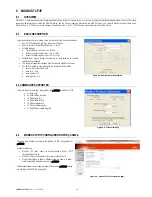
pCOWeb
+030220966 – rel. 1.1 – 12.12.2017
40
8
MODBUS TCP/IP
8.1 OVERVIEW
MODBus is a communication protocol developed by Modicon systems. In simple terms, it is a way of sending information between electronic devices. The device
requesting the information is called the MODBus Master and the devices supplying information are MODBus Slaves. In a standard Modbus network, there is one
Master and up to 247 Slaves, each with a unique Slave Address from 1 to 247. The Master can also write information to the Slaves.
8.2 BASIC
DESCRIPTION
To get your modbus device working, these are the basic things you need to know:
•
Port 502 TCP (default by protocol, cannot be changed)
•
Address format: Decimal (digital number 1 = coil 1)
•
Variable bindings:
Digital variables: coils from 1 up to 2048
Analog variables: registers from 1 up to 5000
Integer variables: registers from 5001 to 10000
•
Variable types: Signed Integers (mandatory in some software to correctly
read/write the variables)
•
The ranges of variablesare aligned with the standard Modbus addresses.
•
The limits of variables are aligned with the standard Modbus limits:
read coils/discrete inputs: 2000
write coils: 1968
read registers: 125
write registers: 123
Figure 8.a - Remote connection example
8.3
COMMANDS SUPPORTED
These are the only commands supported by the
pCOWeb
in modbus TCP/IP
01: Read coils
03: Read holding registers
05: Write single coil
06: Write single registry
15: Write multiple coils
16: Write multiple registers
23: Read/Write multiple Registers
Figure 8.b - Protocol settings
8.4
MODBUS TCP/IP CONFIGURATION FOR
pCOWeb
The page shown below summarises the Modbus TCP/IP configuration for
pCOWeb
.
Available settings are:
•
Modbus TCP status: allows to enable/disable Modbus TCP/IP
communication service;
•
Modbus TCP port: configure port for protocol (default 502)
•
Map mode: it allows to adopt a different mapping scheme, to allow
retrocompatibility with older versions of
pCOWeb
.
Further explanations about mapping schemes throughout
pCOWeb
version
are available in APPENDIX J, on page 83.
Figure 8.c – Modbus TCP/IP configuration page
















































